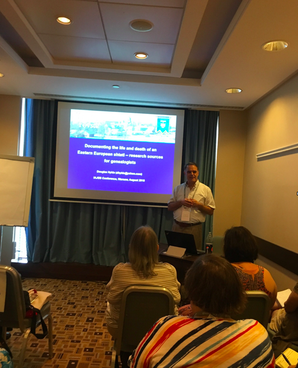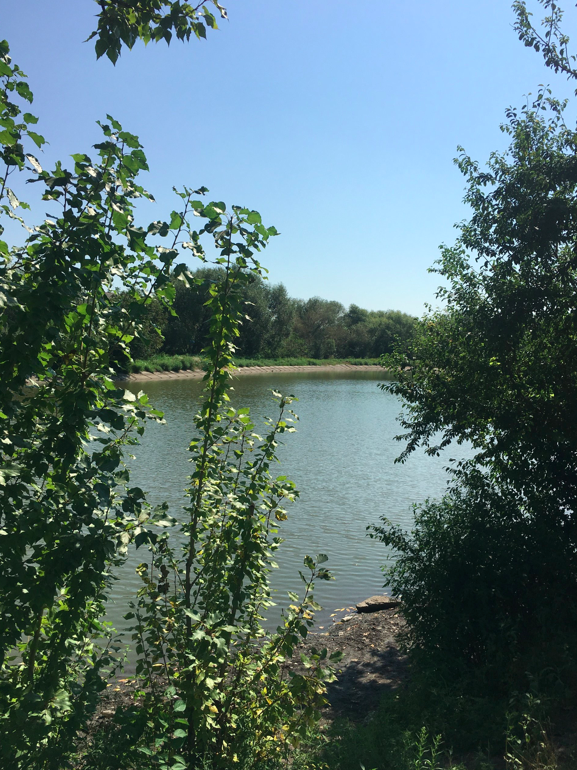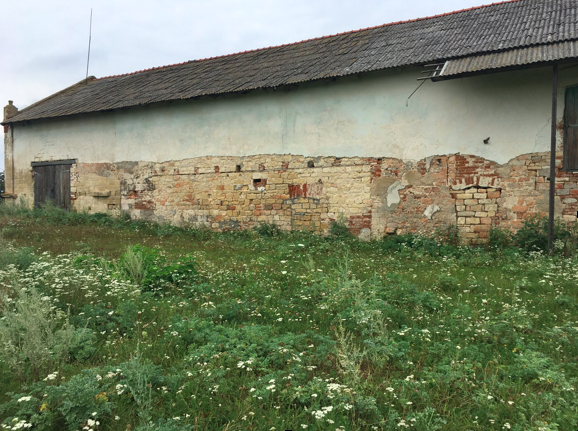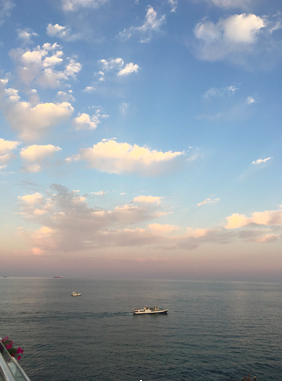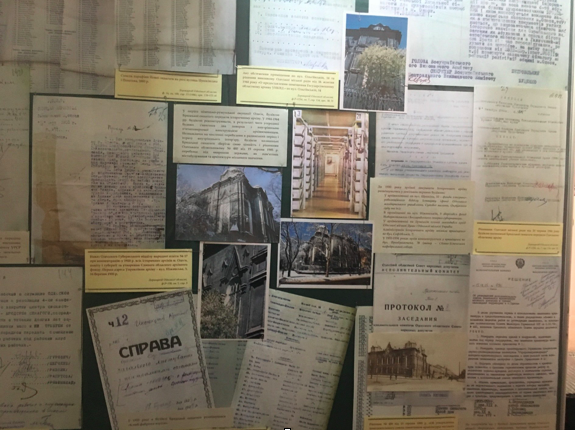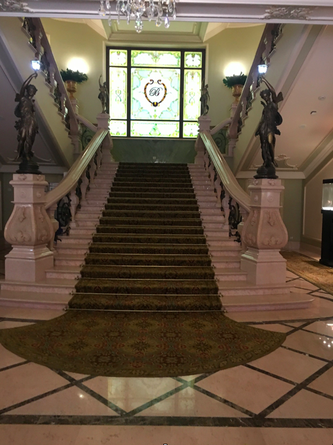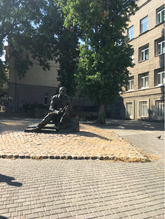Poland & Ukraine
Day 1 •09 Aug, 2018•
|
It was so easy to get to Warsaw! You board the plane, fall asleep and poof wake up here! We are in Warsaw until the weekend. We are here to attend the International Association of Jewish Genealogists Annual Meeting--the first in Poland. When we leave Warsaw, we will fly to Ukraine to begin a week-long tour of the villages where our ancestors lived pre-WWII in Ukraine. Then we will spend a few days in a place I've always dreamed of going to--Odessa! By the time we got to The Westin it was already 2:30 PM. After a short nap, we headed to the Meet and Greet at the conference. Then we viewed a subtle, moving film called "A Shtetl in the Caribbean." It was about two families of Holocaust survivors who, denied visas to the US, settled in Curacao. The film flashed between their visit to their parents' and grandparents' shtetls in Ukraine, interspersed with interviews of people who knew them back in Ukraine who now live in Israel and life in Curacao. It was fascinating. We were sitting a row away from the filmmakers so we got to talk with them afterward. Then Rick and I headed to old town Warsaw for some borsht and perogies! Now it's sleep as we adjust to the Polish clock and try to get up early to attend the conference tomorrow.
|
Day 2 •10 Aug, 2018•
|
Today we checked in at the conference. First we went to the resource room to try and find some more information on Rick's family. An ancestry volunteer helped us discover his grandmother's maiden name--Polanksky--which is a big lead. She also helped us discover that his surname may have been Meler instead of Millan, because that is how it was listed on his grandfather's ship manifest. We also discovered that Rick's grandfather came from Cherkass, the same town as my grandmother's family. So, we might be cousins after all!
The volunteer's name is Ana. She grew up in Canada but now lives in Utah. She studied Sociology at Brigham Young University which prepared her for her ancestry job. I asked her what was most fulfilling about her job and she had this to say, " Your link to the past, when you know where you come from, provides you with your identity. It shows you the challenges your ancestors went through and helps you work through your own challenges. I have eight adopted children. We don't share the same biology, but it doesn't make a difference. I'm there for them and I'm connecting with them across time and distance, the same way I do with the people who came before me." Needless to say, Ana has definitely chosen the right profession. She is an inspiration and was quite helpful in tracking down information we didn't know about Rick's family. At noon, we attended a special luncheon for people with roots in Ukraine. There were three different speakers, all fascinating! The first two described trips they took to find their ancestors' towns in Ukraine. They were super inspiring. Both speakers were able to locate people who knew their families. I am hoping that we will have a similar experience. The second speaker took part in an effort to revitalize the Jewish cemetery in her town. This is something I'm really interested in doing in Ozeryany, so I took good notes. The third speaker spoke a little about problems researching ancestors who live in Eastern Ukraine where the war was/is taking place right now. No, we are not visiting Eastern Ukraine! After that we headed over to the Polin Museum and wound up staying there for over 4 hours. The museum tells the 1,000 year history of the Jews in Poland right up to the present day. Needless to say, we were moved by the sad history of persecution but delighted to discover that Jews are repopulating Poland today. An act of resistance in itself! There are kosher restaurants in Warsaw, an active synagogue, and a growing stronger jewish presence. Who could have ever imagined it? By the time we were done at the Museum, we were so dog-tired that we ate dinner at the hotel and returned to our room. Tomorrow is a big day because we are going to a talk at the conference all about Tluste, which is the town where Joachim Maiman--my great grandmother's brother and other Maiman relatives lived and died in 1942. Then we are going on a tour of the site of the Warsaw ghetto. |
Day 3 •11 Aug, 2018•
|
Today at the conference was nothing short of a miracle. There are very few talks on individual towns, but believe it or not there was one today on Tluste! Tluste is the name of the town that my great grandmother Molly Maiman's brother moved to from Proniatyn. Joachim's mother died in 1897 when he would have been 11 years old. I am conjecturing here in thinking that one of his older siblings took him in. He lived with this sibling (possibly Kalman) in Ozeryany until when he went to college to study agronomy. Then he moved to Tluste where his wife Rivka Koningsberg Liebman's family lived until he got a job as the estate manager of a Folwerk called Zawarka about twenty kilometers away. He and Rivke lived on the Folwerk until they were murdered during the first aktion in 1941.
The name of the person who gave the talk on Tluste is Doug Hykle. Doug has dedicated his life to piecing together the story of Tluste. His grandfather came from Tluste and since he first visited the town maybe twenty years ago, he has become immersed in discovering the history of it and the people who once lived there. He showed pictures of what the town looked like pre- WW II and talked about how to find search further. Afterward, he led a mentoring session so I got to talk with him about Joachim and Rivka. Very uncanny. Doug will be in Tluste the same days that we are, so we agreed to meet there! There is a Maiman house still standing that he will show us. Also, miraculously, he figured out where the estate is where Joachim worked and managed and we hopefully will go there! David (the cousin I am meeting in Lviv from Israel) has heard about the estate all his life. David's mother was Rivka's sister. So, it will be very special to go visit it with David and hear the stories his mother told him about it. After Doug's session, Rick and I went on a tour of the Warsaw Ghetto. Of course, it was destroyed, but we got to see the site where it stood and hear about the heroism of the resisters. It was awe-inspiring. The tour included this amazing trip to the Ringelbaum Musuem. Emmanuel Ringelbaum, who was killed in the ghetto, collected an archive of thousands of papers that detailed the day-to-day life in the ghetto. He hid the writings he collected in milk cans and they were buried underground and found years later! This is the first exhibition of the papers. There was recently a movie made about the findings and it opens this week! The Archive was awe-inspiring, especially hearing about the women who took part in the uprising, though of course everyone was killed except 12 people. Exhausted, Rick and I returned to the concierge floor in the hotel and ate some then retired to our room to prepare for tomorrow, our last day at the conference. |
Day 4 •12 Aug, 2018•
|
Today was phenomenal! First I went to a talk at the conference that a Polish-Jewish woman who now lives in Germany gave about using pre-WWII newspapers to find clues about relatives. I hadn't done this yet, so she gave me a lot of great leads, and she found really interesting information about her great grandmother's family, people she didn't even know existed before she undertook this research! Now she knows intimate details of their lives. Then Rick and I went to a talk about how to photograph gravestones and the importance of doing so. Most of the graves in the old cemeteries are made of sandstone and if you dare to even put a finger on them, they will crumble. The importance of photographing them is paramount. There's an app called billiongraves that lets you enter the pictures you take of your relatives' graves in a world wide catalog and you can do it even if you are not online. We didn't know about the app before the talk, so this is crucial information.
After that, Rick arranged for us to go on a bike tour of the part of town that was mostly Jewish before the war--Praga. Our guide, Lucas, was exceptional and his knowledge steep. 85 percent of Warsaw was destroyed in WWII, but in Praga many buildings still stand. He pointed out the sites of a former Mikvah, some synagogues, schools and houses where Jewish people had lived. Because so few pre-war buildings remain, the government does not permit them to be taken down. So these sites are only now getting beautifully renovated with care to preserve their character and history. The reason it took so long, is because after the Soviets, people reclaimed their former houses and the courts were so tied up with cases, that it has taken all these years to settle them. So, if the home owners can be found and the cases settled, the owners can renovate the houses. Otherwise, they stand in rubble. Bike riding is, we've found, the best way to see a place. We got up close to the structures today, to the remnants of Jewish life and to the ways in which Jewish memory is being preserved. In an hour we are going to Shabbat services and dinner at the main synagogue in Warsaw. There we will meet Warsaw's Jewish community. It turns out that there is a reemergence of Jewish life in Warsaw. Many Poles are discovering that their grandparents or great grandparents had been Jews. And others--such as a group called The Memory Keepers who spoke at the conference--are committed to preserving and rejuvenating Jewish life in Poland. |
Day 6 •14 Aug, 2018•
|
Today was the day I've been waiting for! We arrived in Lviv and we met David, who is the son of my great uncle Joachim Maiman's wife's sister! Joachim and his wife Rivka were both killed in the first aktion in September 1941, but David's mother had moved to Israel in the 1930's from Tluste, where they all had lived.I had no idea that David even existed until I found Joachim and Rivka in Yad Vashem's Hall of Names and followed the witness's testimony to David's tree on Geni where the name Joachim Maiman appeared. I wrote to David, who lives in Israel, and asked him how he was related to Joachim and when he told me Joachim was his mother's brother-in-law, my hands wouldn't stop shaking. We corresponded for months and now we are touring Ukraine together with Rick and also David's wife, Ruthika. We met David and Ruthika for the first time in the main square in Lviv. They are the most wonderful people. This journey is about tracing the past but it is also about deepening our lives with living connections to take us forward into the future.Then we had dinner together on the rooftop of the Leopolis Hotel, which looked like a scene right out of Mary Poppins with slated, red chimneys everywhere we looked. In the morning we met our guide Alex Dunai and drove the three hours to David's father's towns--Berezne and Sosnove (also called Ludipol)--where we actually met random women on the street who led us--one on her bicycle-- to the site of the mass graves where David's grandparents and extended family were killed by the Nazis in 1942. We would have never found the sites on our own because they were deep in the forest. The woman on the bicycle who led us to the grave in Sosnove knew where it was because she had come across it while foraging for mushrooms. Seeing the mass graves was shattering, but also made it possible for David to pay tribute and honor their memory along with the thousands of other Jews buried at the site. Rick led us in Kaddish and we placed stones on the monuments.The woman who led us there insisted on giving each of us a jar of her marinated mushrooms.She invited us to her home for tea but we had been on the road since 10 a.m. and it was already close to 7 p.m, so we needed to decline.
|
Day 7 •15 Aug, 2018•
|
Today was totally amazing because we began the journey of the Maiman family. We drove to Proniatyn where my great great grandmother Ettie Weinraub Maiman and her husband Meir Maiman lived. I don't know how long they lived there or how or why they happened to come there. These are all questions that need to be researched. What I do know is that at least one of the children, my great-uncle Joachim Maiman was born there and it was there that he met his wife Rivka. The village was beautiful--an affluent suburb of Ternopil on a hill above it and overlooking the river. Very few of the original houses remained. We stopped some residents and they told us that few Jews had lived there. Just when we thought we would not find any remnants of the past, I asked Alex to stop the car. I merely wanted to feel the earth beneath my feet in this place. And as soon as I got out of the car, I stopped by a house--number 8--that looked like it could have been built before 1900. And sure enough, Alex (an historian) said it was! It might not have been the exact house where the Weinraub/Maimans lived but it was an example and it was on the same street where they had once walked. The uncanny thing was that someone was working on the house. It turned out to be a youngish guy who spoke English! He told us that it was a friend's house, whose grandmother had lived there. This guy was going to tear it down. He invited us inside. I produced a shock of tears. Maybe it wasn't the actual house my great great grandmother and some of her children lived in but it was just like it. The ceilings were very low and the floor was a mixture of dirt and plaster or cement. The slanted roof was built in the characteristic style of the time. The walls were torn open in places and there was an old bed in the corner. It looked like it came right out of the pages of Sholom Aleichim. Tomorrow we will travel to the town where Joachim and Rivka lived after they got married.
|
Days 8 & 9 •16 & 17 Aug, 2018•
|
Unfortunately, I couldn't connect to the internet yesterday, so I will explain days 8 and 9 together. The way we have arranged these days is to tell the story of the Maimans and where they intersect with David Kelrich mother's family. The Maiman family started out in Proniatyn, then moved to Zwiahel, then Ozeryany and Tluste, and cousins and relatives lived in other nearby towns as well. We had gone to Pronyiatyn the day before, but instead of going to Zwiahel next, because of the driving distances, we went to Tluste. David's family (Leibman and Koningsberg, Thaler and others) lived in Tluste.
How our families intersect is that David's mother Malka Liebman Thaler had a sister Rivka Liebman Maiman who married my great great uncle (our Kessler great grandmother Molly Maiman's brother) Joachim Maiman and they lived in Tluste maybe after they got married. Also many other Maiman cousins and relatives lived there too. We drove through the center of town and stopped there to meet Doug Hykle, a researcher I had met at the Jewish Genealogy Conference in Poland. He had given a talk on, of all places, Tluste! Doug gave me his phone number in Tluste because it just so happened he was going to be there the same time as us. So we met him and he gave us a tour of the town. He's been dedicating the last 20 years of his life to learning all about Tluste, so we were fortunate to have met with him. Doug pointed out some of the houses still standing that had once been Jewish. In fact, one of them was a large house that belonged to one of the Maimans. We don't know who and if they were relatives or not, but they did have that name. After we left Doug, we stopped at the Jewish cemetery and the site of the mass grave to say Kaddish and to look at the tombstones for relatives, especially David's who had lived and been murdered in the town. (Most of my relatives had lived in and were killed in Ozeryany). It was difficult to make out the writing on the tombstones under the blazing hot sun, but David did find the tomb Federer, the father of someone from the Tluste Association in Israel. I have read horrendous accounts of the mass killings in Tluste, so it was a difficult place to be standing. Actually, Joachim and Rivka eventually moved to a farm manor or estate where Joachim had the job as manager after getting his degree at University in either Lviv or Tluste in agronomy. Doug and David had figured out the name of this place as Zarawka because David had a letter that Joachim and Rivka and other letters that Rivka's mother had written to his mother postmarked from Zarawka in or near Zalestricke. She had left Tluste for then Palestine in 1933, so of course her mother and sister would be sending letters back and forth. In one (and more) of these letters the return address was Zarawka and since we knew that Joachim and Rivka lived on a manor or Folwerk we knew could figure out where the manor used to be. Also, David's mother went back to Tluste (then Poland) as a tourist in 1938 and David had grown up hearing stories about her trip. She had stayed in Zalestricke, Zarawka and Tluste and urged her relatives to leave. But, tragically, they refused. Even so, it was difficult to find Zarawka and only did so after asking multiple people and driving through unpaved roads and fields. The place was covered in weeds and the main manor was gone, but one building was standing. We think it was a vokda refinery. But the acreage spread as far as the eye could see to forested hills, so we got a sense of how large the farm had once been and imagined Joachim on his white horse managing the workers. Then we went back to the town and our guide, Alex, stopped people we saw on the street. In this way, Alex found a family whose mother was one-hundred years old and might remember Jewish people pre-1942. This one-hundred year old woman was bent over but completely sound of mind! She did remember some Jewish people, but she didn't remember any Maimans. However, her son or son-in-law who was working inside the house (it was like an open air house so he could hear us) didn't show any interest at all in the conversation until when we mentioned the name 'Maiman' and he jumped out of the room and came forward and corrected our American pronunciation of Maiman. He told us that yes, he remembered the name Maiman (pronouncing it in his Ukrainian way) and that whenever he misbehaved, his mother would say "be good, or I will bring you to Maiman and he will punish you." He also told us that he remembered seeing this Maiman, a man of an impeccable appearance ride around on a large horse. They then told us some stories about some of the other Jewish people living in the town. At the end, they asked us if we would help locate the 100-year-old mother's brother who had immigrated to the US. They had lost contact with him during the Soviet era because people were afraid to write letters to the US during that time. If they did, they might be accused of being spies. We told them we would try our best to find the ship manifest of their relative and exchanged addresses. Needless to say, it was a day of days. To actually meet someone who could tell us about our relatives and for us to know that although these relatives met a horrible end--both Joachim and Rivka were murdered in Tluste during the first aktion--we got to be near the fields where they worked, the streets where they walked and the people who knew them when they were alive. One other side note--now I understand quite a lot about my Kessler family who are Maiman descendants. Harry Kessler, the man I am named after, retired at age 50 and became a gentleman farmer. He bought a hundred acre farm in Wycombe, Bucks Co, which was unusual for Jewish people to do at that time. My fondest memories of growing up was going to the farm to visit his widow, my aunt Annie --we called her 'Annie in the country.' Now I am thinking that Jaochim Maiman's love for rural life inspired my uncle Harry. Harry was fifteen when he left Tluste/Ozeryany. Surely, he had been to Zarawka. Surely he must have been compelled to sell his house in Philadelphia and to recreate a place that looked something like Zarawka in the fields of Bucks County, PA! |
MORE ON DAY 8 AND 9
After visiting Tluste and Zarawka, we went to Ozeryany where Molly Maimon's sisters and brothers were born, including Joachim. This was an incredible experience. Again, our guide, Alex, asked people on the street if they remembered the Jewish people who use to live here. In this way, we were taken to the house of a eighty-five year old man whose father knew many of the Jewish people who lived in the town and had even spoken Yiddish. His wife's mother had hidden a Jewish person but eventually that person left the place of hiding and was killed. He then took us to an abandoned house where he told us someone with the last name of Weinraub had lived. We were able to go inside it and walk from room to room. Alex told us that if the house had been changed since Weinraubs lived in it, the windows and doors would have been the same. I think this was the house of one of my relatives. Even though we know their last name as Maiman, they often went under their mother's maiden name. In this case it would have been Weinraub. This hunch was further confirmed when the 85-year old man took us to the house of someone named Paulina. Paulina was in her 90's She sat under the shade of a tree and in her soft voice tried to remember what she could. She said she remembered a person named Kalman. Well, Kalman is one of Molly Maiman's brothers! And if he used his mother's maiden name, as I suspect he did, his name would be Kalman Weinraub. Maybe that Weinraub house had belonged to Kalman. Paulina also said that she remembered someone named Mordechai. On Yad Vashem's Hall of Names, I discovered that Mordechai was the name of the Kalman's son. So she remembered both Kalman and Mordechai. They were both killed in the first aktion along with Kalman's wife and their other children and grandchildren and his other brother Pesach and sister Basia. Pauline only remembered the names Kalman and Mordechai, and she kept saying them over and over. I am sure there is so much more that she didn't tell us at that moment and if we could go back and talk with her again, she would remember more. We then went to the cemetery in Ozeryany where I disovered on JRI Poland that Ettie Weinraub, Meir Weinraub and their 17-year old daughter Chanje are buried. We walked through fields abundant with Queen Anne's lace, daisies, prickly vines and leaves trying to get to the tombstones. The tombstones that went back to 1897 were in the forest so we couldn't get to them, but that is probably where my great great grandparents' tombstones would be. Besides being a burial ground for people who died before WWII, it was the place where the Nazis deposited the bodies of the people they killed from the town. The entire cemetery was a huge mass grave. If you go on Father Desbois' website you can read about what happened here. Father Desbois is dedicating his life to mapping the unmarked graves throughout Galicia. We ended our visit by saying Kaddish for the dead. Then we traveled to Zwiahel where my grandmother Yetta was born!!! I could write pages about this place. It's absolutely beautiful! It's up on an unmarked road up high with a magnificent view of the valley below. We couldn't find the actual house where Yetta was born, (though I knew the exact number), because the houses had been destroyed and the numbers had been changed. I also have a picture of Molly Maiman and maybe her husband Friedl and one or two of her brothers that were taken there before Molly left for the US and the place looks exactly the way it did in the picture. I mostly saw Zwiahel from the van and only got out for about 5 minutes. I would have been nice to have spent more time there, but I did get to smell the air and walk on the ground. It was a beautiful place and I was happy that Molly had lived in such a beautiful place and also of course that she came to the US. It must have been a hard decision to leave, one I can really understand now. She is the only one of her seven siblings to have survived. The others--Basia, Pesach, and Kalman were killed by the Nazis. Julius went to live in Bucharest and was killed in WWI. Chanje died of typhus at age 17 and Joachim married Rivka and moved to her parents' town, Tluste, and then in Zawarka where he worked as the estate manager until the Germans killed him. I still don't know how or where he died. |
Day 10 •18 Aug, 2018•
|
Yesterday we said goodbye to David and Rutheika in the medieval city of Kaments-Podilsky, with the promise of meeting up with them again in Israel, then Rick and I went on to the former Russian Empire. The land on this leg of the journey looks exactly the way I pictured it from reading about it all my life. The fields are rich and dark and the grass is lush under the blue sky. First however, we drove around the walls of the impressive of the medieval fortress in Kaments and a little bit of the town.
It was mostly a travel day, however we stopped for an hour in Medzhybizh which is where the Ba'al Shem Tov had established his school and is buried. Incidentally, the Ba'al Shem Tov also lived in Tovste/Tluste, so we were following his route. He arrived in Medzybizh, a place which means between two rivers (the town is built between the rivers Buh and Buzhenka). It was totally amazing to drive up to the town and see Hebrew letters and Hasids. We felt like we were entering a shtetl from the past. We really got a sense of what it must have been like. When we arrived, a service was going on in the shul where the Ba'al Shem Tov is buried, so we waited until it was over to enter. A special service was going on to welcome the Ba'al Shem Tovs' 8th generation grandson who was visiting from New York. We didn't see the actual grandson, but one of the Hasids explained to us that there were a lot of important rabbis at the site that day. While we waited for the service to be over, we drove to the site of the Jewish cemetery and the mass grave. Over 3,000 Jews were exterminated there and the area where the mass grave stood was quite large. Again we said Kaddish to help raise the spirits of the dead. I don't have much time to write now and need to expand upon this later because the town is a very beautiful, very amazing place where the followers of the Ba'al Shem Tov still gather. After we visited the synagogue where the Ba'al Shem Tov addressed his followers, the school where classes were held and his grave, we drove on to Vinnitsia--a town with a very bloody past for all involved--where we spent the night. |
Day 13 •21 Aug, 2018•
|
What a miracle to arrive in the city and leave the bloody history of the villages behind. Of course, atrocities occurred in Odessa too, yet city life is a welcome distraction. Besides economics, I understand why our ancestors left their small villages for city life. In the village there is a constant reminder and time seems to stand still. City life is fresh and energetic, making oblivion possible. Plus our hotel, The Amsterdam, is so totally hip. A boutique luxury hotel with a 24-hour gourmet restaurant and bar, it feels like The Ace Hotel in New York where Teddi used to work.
We had a really interesting day yesterday. First we went to the beach and paid for a cushioned lounge-chair-like-couch where we were able to lie under an umbrella in the shade only steps from the Black Sea. The spot we took was more deserted, because the beach was filled with people in the way of many European beaches where the people sit stacked up next to one another, and we tried to look for a more crowded spot.The Black Sea looks like an ocean with waves and a sand shore. It isn't black though, it's greenish. It has a lot of seaweed in it. I don't know if it is always so filled with seaweed or just now during this summer's heat wave. Instead of selling ice-cream the way they do on the beach at the Jersey Shore, boys were walking up and down the rows of people selling smelts and sardines (see picture below). I was tempted to buy some because smelts and sardines are my favorite fish, but I resisted too afraid of getting sick. The Black Sea, though very far away, is actually connected to the Mediterranean and the beach area has a Mediterranean feel to it. In fact, it is compared to Ibiza in many of the descriptions. We've been to Ibiza, so we looked for comparisons. It did have a slight Ibiza-like energy and then we found the volcanic rock tub-like formations that were somewhat like the ones in Ibiza, where you can sit and feel the water rush up to cover you, though not on the same scale. So, no, I wouldn't compare it to Ibiza. Nevertheless, we stayed for three hours, then left to do some research on Rick's family in the Odessa State Archives, then returned to the beach--this time at a beach club with a large, refreshing pool--around 6 PM and stayed until 9. At the beach club's roof top restaurant, we had a great view of the sea and sunset, which here is on the opposite side! I ordered black sea mussels (pictured above) which are a speciality and are only available in Ukraine. It was great to finally spend the day doing nothing and unwind. We didn't have time to go the Polish State Archives, so we were sure to make time for an archive visit in Odessa.The archives were housed in the former Brodsky synagogue. We got to do something I've always wanted to do--go through original archives to find evidence of family. Alex helped us because the entries were in old-fashioned hard to read handwriting in Russian. I can read Russian handwriting, but of course, Alex could do a much better job. I don't think we'd have made much progress without him. Even getting permission to go into the Archive building was difficult. We were asked many questions and had to produce identification cards. Once we were permitted to go into the archive room, Alex ordered archives dating back to 1910 to search for Yanishevsky, Rick's maternal grandparents' name. Rick's great grandparents had 12 children. We think they were all boys. Rick grew up knowing two of them, his Uncle Morris and his grandfather, Harry. A third visited from the Soviet Union in the 1970's, but he returned, and the family lost contact with him. A fourth, Rick later in life discovered, immigrated to New York. So he has only been able to account for four of them. We are thinking that if any of them survived WWII, then maybe they would have had children who still live in Odessa. We did find a few entries that we would aid us in conducting follow up research online, so at least we have a place to start when we return home. Of course, we won't be able to make contact with any of them here, as we had dreamed. I will need to describe this more later but today is another day and it is packed. We are going to the the Odessa Literary Museum (my favorite writer Issac Babel is from Odessa) and then a tour of the part of Odessa where the Jewish people lived who Babel wrote about before the World Wars. Babel was killed by Stalin in the 1940's, not only for being Jewish, but because he had an affair with the wife of a high ranking officer in the Red Army. In the evening we are going to meet a friend of a friend--a Jewish writer who lives here. Fortunately, we had the beach day, because we are on to another packed day! |
Day 14 •22 Aug, 2018•
|
Akhmatova, Babel and other Russian and Ukrainian writers who had spent time in Odessa. Seeing Issac Babel's spectacles was particularly sorrowful. The story goes that after Babel was arrested by Stalin and condemned to death, he handed his spectacles to his wife and said 'take these, I won't need them anymore.'
Next we went on a walking tour of the Jewish parts of Odessa with a wonderful guide who explained the history of the town with specific emphasis on Jewish history. She showed us the sites of numerous pogroms that took place in Odessa starting back in the 1800's. Fortunately, the Jews who were rounded up and killed during the Holocaust in harbor warehouses along the sea were not taken to the present site of Nemo, the beach club were we hung out yesterday, or else we'd have been very upset by our choice. Every street is so layered in history that it is impossible to not step into it. Such is the problem of living in a place like Odessa. Part of our walking tour included a visit to the site of Issac Babel's house, the Russian-Jewish writer from Odessa who got me interested in the city back when I was in high school and could not read his work without stopping to gasp at the beauty of every sentence, even in translation. To this day, I am obsessed with Babel. Seeing the settings where his books took place moved and inspired me. The ironic part is that when I was a teen-ager reading Babel, I used to want to meet people like his characters so badly. At that time, I hadn't yet figured out that the descendants of the people his characters are based on lived in my Jewish neighborhood in Northeast Philadelphia. What an opportunity I missed to tell the story of the people I saw everyday. Well that's the difference between Babel and me. He saw the humanity in people. Babel was a genius! Once we found the synagogue, we ate at its kosher restaurant twice. I ordered gefilte fish! No offense, Mom, but it was the best I'd ever tasted! The area where the Jews lived is now being renovated and turned into a very new, very hip section of the city. The buildings had stood abandoned for many years. The picture of the staircase in the hotel above is from an original very ornate turn of the century building. Now Hasids own the hotel! The Hasids are buying these old sites and renovating them too. After our tour, we went to visit Boris at his dacha about 40 minutes outside of the city. Boris is a friend of my Bryn Mawr friend, Russian-Jewish poet, Olga Lifshin. Boris was a dissident writer and activist most of his life and as such was blacklisted from teaching and publishing his poetry. He has suffered immensely under the Soviets, both as a poet and as a Jew. Being here, you really get the perspective of how the Soviets tried to further the Nazi's work of wiping out the Jews. Boris told me he didn't know a thing about being Jewish until he was 40 years old. Under the Soviets, it was illegal to talk about Judaism or say that you were a Jew or to even say that Jews died in the Holocaust, which explains the absence of plagues and memorials even to this day. Most of the memorials we saw throughout Ukraine were built with American and Israeli donations and not by the government of Ukraine. When Boris's grandmother finally told him about the religion, she made him promise not to repeat those things to anyone. I've read several of his poems in translation and they are marvels, which was why I wanted to meet him in person. If you want to check out his work, get a copy of the new anthology WORDS FOR WAR published by The Academic Press. The book is a selection of Ukrainian poets in translation writing about their experiences of the war in Crimea and living under the constant threat of a Russian invasion. Boris told me that he is the sole PEN member living in Odessa. It was a true honor spending time with him and hearing about life in Ukraine and particularly Odessa from his point of view. It turned out that his parents came from the same village (Bershad) as Rick's. We ended the day with dinner back at the kosher restaurant in the still functioning synagogue. The reason the synagogue did not get bombed during WWII is because at that time the Soviets had closed it and it was being used as a gym. Thus, the synagogue still stands in all its splendor. Irony upon irony: a perfect finale to our trip. There are still close to 50,000 Jewish people living in Odessa. These are the survivors. |




